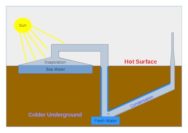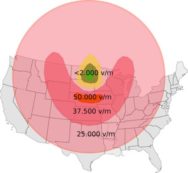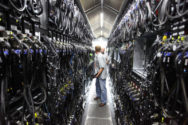
Gadget produces solar power and clean water
Multi-membrane solar panel uses waste heat to warm water and thereby purify it – Saudi researchers hope to ready it for commercial rollout soon…

Multi-membrane solar panel uses waste heat to warm water and thereby purify it – Saudi researchers hope to ready it for commercial rollout soon…

Power company PG&E has long been known as a company that puts its shareholders interests ahead of its customers – shady billing practices, low quality maintenance are just a couple of the company’s bad practices.
Now it has gone a step further with a plan to punish its 15 million Californian customers in the event of wildfires this summer.
When high winds arise this year, the utility says it will black out fire-prone areas that are home to 5.4 million people.
That’s right – instead of working 24/7 to prevent its power lines from sparking the kinds of wildfires that have killed scores of Californians. it plans to pull the plug on a giant swath of the state’s population.
No U.S. utility has ever blacked out so many people on purpose. PG&E says it could knock out power to as much as an eighth of the state’s population for as long as five days when dangerously high winds arise. Communities likely to get shut off worry PG&E will put people in danger, especially the sick and elderly, and cause financial losses with slim hope of compensation.
In October, in a test run of sorts, PG&E for the first time cut power to several small communities over wildfire concerns, including the small Napa Valley town of Calistoga, for about two days. Emergency officials raced door-to-door to check on elderly residents, some of whom relied on electric medical devices. Grocers dumped spoiling inventory. Hotels lost business.
PG&E is “essentially shifting all of the burden, all of the losses onto everyone else,” said Dylan Feik, who was Calistoga city manager until earlier this month.
By shutting off power in fire-prone parts of its service area, which are home to 5.4 million people, PG&E said in regulatory filings it hopes to prevent more deadly wildfires. The San Francisco-based company sought bankruptcy protection in January, citing more than $30 billion in potential damages from fires linked to its equipment.
This plan amounts to an admission by PG&E that it can’t always fulfill its basic job of delivering electricity both safely and reliably. Years of drought and a drying climate have turned the state’s northern forests into a tinderbox, and the utility has failed to make needed investments to make its grid sturdier.
During this year’s wildfire season, which typically starts around June, PG&E is preparing to make cutoffs to a far larger geographic region than it has targeted for blackouts in the past, increasing the number of potentially affected customers nearly 10-fold. While it is unlikely all areas would be affected at once, the outages may turn entire counties dark.
SHARE YOUR THOUGHTS
What should utilities do to protect people from wildfires? Make your comments below.
The company said it is attempting to figure out how to avoid stranding medically vulnerable residents and is working with local authorities to try to ensure water, traffic …

By Ken Torino of K-Tor – Human-power expert

My story began 15 years ago when I was looking to buy a
I was an an avid hiker and a believer in self reliance during the 30 years I lived in Vermont.
When I retired from IBM, I started a company focused on human powered generators.
Pros and Cons
You might ask “what is the role of human power energy in the modern age” — gas power generators and solar panels are available. The answer is they all have their roles and plus and minuses.
Human power: of course you need to pedal and it is limited in the amount of power by the human being, typically about 75 watts. On the plus side human power always works and can be used in sheltered locations and stored inside as well as is portable.
Solar charges mainly between 10am and 2pm and stores this in
a battery for use. So the solar panels need to be out in the open and there needs to be sunlight, under tree canopy of cloudy skies reduces power, and you need a battery pack large enough to store the energy of the four hours to be used over the next 20. It can generate lots of power as you can scale the surface area of the solar panels and battery pack size. Usually they are not mobile.
Gas generators generally come in a power range but 4000
watts is a typical size, although larger sizes are available. Gas generators also must be placed outside away from dwellings. They
are not easily portable. They make a lot of noise; give off noxious exhaust and of course you have to have a source of gas. Gas is usually pumped from the ground using electricity so is typically in short supply in times of emergency.
As an example in the recent hurricanes in the Caribbean most
of the solar panels that were on roofs were destroyed and gas was hard to get for some time. Human power of course could not run refrigerators or air conditioners. The best strategy is a complimentary strategy. As they say, two is one and one is none.
After K-Tor was founded, the first two years were spent researching
human power energy and developing the first product.
Currently the company has three main generator products, the
Pocket Socket 2 a USB 1 Amp hand crank generator and two pedal generators, a 20 Watt model and a just released a 50 watt model.
Over the past 10 years K-Tor has acquired a lot of expertise in the area of human power energy and the uses of electrical energy and its devices in off the grid and emergency uses. We have many people come to us for advice …
Its a little known fact that the Marijuana growers of Northern California were amongst the first to use solar panels to improve their crop yields, back in the mid 1970s. Forty years later they are still at the forefront of energy innovation, and a burgeoning number of utility companies are working with cannabis cultivators to better manage costs by:
* Assigning employees to work exclusively with marijuana businesses.
* Recommending lighting, heating, ventilation and air-conditioning (HVAC) systems, which they say can save cultivators tens of thousands of dollars annually.
Here are some of the points growers are focusing on as they consider potential energy savings:
1. Electricity consumption typically is the second-largest cost incurred by indoor cultivation facilities.T
2. Find a Utility executive who is willing to focus on you 0 In May of 2017, I started devoting 100% of my time to the cannabis operations coming into our territory, knowing that all those companies were going to fill one portfolio of commercial account management,” said Matt McGregor, strategic account manager, cannabis operations, for the Sacramento Municipal Utility District (SMUD).McGregor estimates he has roughly 200 marijuana customers, mostly growers, but also about two dozen customers involved in extraction, infusion, processing and packaging.
3. Go to private utility companies, not government funded or municipal Utlities. Private utilities are investor-owned, for-profit corporations; public utilities are government-owned.Public utilities risk losing their licenses.Private utilities don’t have those constraints. Consider Puget Sound Energy (PSE) in Washington state, which has helped about 80 cannabis customers with about 100 energy-savings projects since 2014. PSE buys the power it sells to customers off the market or from its own power generation.“So, we didn’t have to be concerned about losing federal funding by serving the cannabis sector,” said David Montgomery, an energy management engineer with PGE.
4.Find a private energy company that operates in your own State. Xcel Energy – a private utility operator serving eight Western and Midwestern states including Colorado – goes by the same premise.“We work with marijuana companies because they are legal operating entities in the state of Colorado,” Xcel spokesman Mark Stutz said.”We are regulated at the state level, and to deny services would be in violation of state law.”
5. Remember what the Utility stands to gain – Utility companies may have to build new power plants to supply customers’ demands, which is costly. It’s cheaper to persuade existing customers to reduce energy usage by using conservation practices and buying newer, more efficient lighting and HVAC.
Now, utilities are looking to the cannabis industry as a place where they can help customers take pressure off the grid.“With the legalization of the cannabis market in Massachusetts, and the fact that this business is extremely energy-intensive, this is an agricultural area where there is opportunity to proactively influence the design of these facilities in order to mitigate their very significant energy demand,” noted

When folks first hear about Tyalgum, in East Australia they picture Mad Max.
Steampunk locals power this dieselpunk outpost with renewable, ethanol-based Guzzolene. Tyalgum has free Wi-Fi and a day spa.
Tyalgum is also going off the grid.
And for the people in this bohemian town in Australia’s east coast hinterland, the stakes are high.
A tourist may be forgiven for ignoring the harsh realities of climate change in such a picturesque spot, but the locals are serious. They’re concerned about carbon emissions and rising temperatures. They’re sick of relying on coal-fired power stations for their electricity.
They’re not the only ones. As the existential threat of climate change grows, people and communities across the world are growing frustrated with governments dragging their feet on environmental policy and investment in renewable energy.
Australia is deeply dependent on fossil fuels, with around 90 percent of the country’s energy generation coming from oil, coal and gas. Australia’s federal government is unabashedly pro-coal. While other nations turn to renewables, Australia contemplates building a massive coal mine in the northeast of the country. When debates about volatile power prices hit the news, Australian politicians call for the construction of more coal-burning power plants. In 2017, the deputy prime minister at the time said he would support clean energy targets — if they included coal.
But climate change is real, and Eastern Australia is feeling the effects. With unstable energy prices, statewide blackouts and a fierce debate over fossil fuels, more Australians than ever want to take action on electricity.
For the people of Tyalgum, solar is the future.
That’s where the Tyalgum Energy Project comes in. The ambitious project wants to power the entire town with 100 percent renewable energy and, one day, begin selling excess power to the wider local area, turning Tyalgum into a community-owned energy retailer in its own right.
Tyalgum isn’t alone. Far from it. Just down the road, the town of Lismore switched on Australia’s first community-owned solar project back in January. The 99kW solar farm floats on the overflow pond at the town’s sewage treatment plant.
From homeowners installing a few solar panels on the roof to entire community-owned solar projects, Australians are starting to take back their power.
There’s a reason Australia is called the “sunburnt country.” The continent has the highest solar radiation per square meter in the world, according to Geoscience Australia. Despite its sunny disposition, the country is 15th on the World Bank’s ranking for sustainable energy use.
Australian communities and businesses are beginning to switch to renewables, though. Elon Musk’s Tesla, best known for electric cars, just installed the “world’s biggest” lithium-ion battery farm in South Australia. AGL, one of the country’s biggest energy providers, has plans to convert one of its ageing coal-fired power stations into a clean energy hub. And the country’s biggest beer maker, Carlton United Breweries, is moving toward …

An Australian housebuilder has launched a search for a family to live in its prototype Home with No Energy Bills.
Mirvac is building the house in a suburb of Melbourne – the least sunny spot in Australia, with a total of 2028 hours of sunshine per year. The problem is striking the right balance between free energy from the sun, and power-hogging cooling bills in the hottest months.
The company is currently searching for a photogenic young family to live “free” in its “house with no bills” “for a year.”
And the idea that a brand new prototype home will generate no bills is laughable when you consider the number of little things that go wrong in every new home during the first year. The moving costs alone on this project will be excessive.
It will be hard to find just the right individuals – sassy enough to give good interviews, but willing to play along as the PR department dreams turn into a DIY nightmare.
Mirvac has teamed up with a group of tech companies around the Pacific rim including Fujitsu and Fischer & Paykel, both renowned for putting PR stunts ahead of reality.
Off-Grid forecasts the story if it appears, will be less than forthcoming about the actual cost of the huge number of batteries that will be needed so that their typical family can always flick on the light switch. There is also considerable doubt over the size of the solar panels and inverters. These numbers will no doubt be kept away from prying eyes as part of the “ proprietary information” that will give Mirvac the “commercial edge” in its future eco-builds.
The company is trying to wrap itself up in the sustainability flag, while building developments of 2,000 homes. Surely the local media outlets are not going to fall for that one?
“The first ‘House with No Bills’ will become home to a key worker family of four over a 12 month period,” says the press release. In an industry-first initiative, Mirvac will utilise a long-range study to follow their energy useage (sic) within the home to uncover how average families consume energy and how the house design and associated sustainable technology performs.”
Leaving aside the bloopers, how will a 12-month freebie for this unfortunate family turn into a “long range study”? And given the energy is all free for the family, what possible motive will they have to limit their consumption? Saving the planet is all very well, but once the “key worker family” are tucked up in bed and one of them remembers she left the lights on in the kitchen, will she really respond in the same way as if she was paying?
The rest of the PR blurb runs as follows: “The House with No Bills is an innovative initiative forming part of Mirvac’s ambitious sustainability strategy ‘This Changes Everything’, which …

Backup batteries? Got ’em. Mobile charging stations? Check. But I need a mobile battery that will keep my beer cold and charge my phone and laptop all day when I am in the field — my off-grid field that is.
River, by EcoFlow, checks all the boxes.
It’s not what you’d call practical, at least not in the sense that you can stow it in a pocket or backpack. After all, it’s about the size of a car battery and tips the scales at a whopping 11 pounds. But there’s no denying its utility. A single top-up takes about six hours via wall charger (or nine hours by car charger) and lasts a year. Once charged, River can supply a total of up to 500 watts to 11 devices simultaneously.
This mobile battery has a ridiculous number of ports. You’ll find two USB 2.0 Quick charge ports, two regular USB ports, two USB-C ports, two AC outlets, two DC outlets, and one 12V car port. The 114,000mAH battery is also smart enough to regulate voltage, giving each device precisely what it needs without going all Note 7 on us.
For the outdoorsman, there’s even a River foldable solar panel ($299) capable of fully charging the power supply in 10 to 15 hours (dependent on weather). It’s also water resistant with an IP63 certification. That’s not quite up to modern smartphone standards, but it can handle the occasional splash.
With a battery this reliable and any top quality solar panel I really can go for days without needing a Utility supply. I still need to be careful not to waste power – turn the laptop and phone off when not in use, but its a case of swings and roundabouts. The freedom is worth the extra hassle.…

For years North Korea has sought to be a nuclear power. Now it is thought that the hermit nation has another weapon which could wreak havoc on our electricity, satellite and communications grids in North America – an Electro Magnetic Pulse bomb.
This weapon might be well known to some, however, it appears to be regularly overlooked by mainstream media services in the west.
An electromagnetic pulse (EMP) weapon which has the potential to disable the complicated and intertwined grid we rely on every single day.
During a US Homeland Security hearing last week, experts told Congress that North Korea is capable of launching an EMP attack on the United States and warned government officials not to ignore the “doomsday scenario.”
Chairman Dr. William R. Graham and Chief of Staff Dr. Peter Vincent Pry, of the Commission to Assess the Threat to the United States from Electromagnetic Pulse Attack, said that such a weapon could “shut down the electric power grid for an indefinite period, leading to the death within a year of up to 90 percent of all Americans.”
Although some critics of the report have associated the 90 percent figure with a popular novel titled, “One Second After.”
According to the Congressional Electro Magnetic Pulse Commission, North Korea has been working on Electro Magnetic Pulse technology for a while and maintain that the rogue regime has probably been testing such weapons since 2006.
An EMP Weapon isn’t like the dreaded Hydrogen bombs which have recently been tested. It is instead designed to emit gamma rays which cause the EMP effect, and is a very small device in comparison to hydrogen bombs and doesn’t need a large explosion to detonate it.
However accurate the figures or statements are, the potential for such a weapon provides even more rationale to the Off-Grid argument.

The European Union (EU) devotes huge resources to delivering the power grid to every nook and cranny of Europe. Brussels is on a mission to stamp out off-grid living which it wrongly equates with poverty and deprivation.
Despite the promise of off-grid solar, 99 percent of EU energy funding still goes to grid projects. The EU has always served the interests of the big energy producers, including state-owned Nuclear power companies and the global oil giants.
The same is true in EU foreign policy towards the world’s most underdeveloped countries, where EU and other central government aid is focused on huge infrastructure projects rather than simple practical steps towards providing off-grid energy.
Despite innovative off-grid technology and high-profile initiatives, electrification in sub-Saharan Africa still trails population growth. In 2009 there were 585 million people in the region without power. Five years later, that figure had risen to 632 million, according to the latest International Energy Agency statistics.
A United Nations analysis of the flow of capital, released in September by the United Nations’ Sustainable Energy for All program, shows that off-grid systems simply are not getting the support they deserve.
“This research shows that only 1 percent of financing for electrification is going into this very promising and dynamic energy solution,” says program CEO Rachel Kyte, who calls the findings “a wake-up call” to the international community.
The 20 countries targeted in the U.N. report account for 80 percent of the estimated 1.06 billion people around the globe living without electricity. The report found that total investment in electricity infrastructure averaged US $19.4 billion a year in 2013 and 2014 (the latest year with full statistics). Of that, only $200 million per year was dedicated to off-grid systems.
This is “alarming,” the authors write, considering off-grid solar’s “enormous promise” to rapidly and cheaply deliver basic electrical services compared with the ability of traditional grids. The International Energy Agency estimates that 70 percent of rural electrification is best achieved by off-grid systems, including solar.
The report does note a few hopeful developments: The World Bank this year committed $150 million to rural off-grid renewable projects in Kenya, and companies installing pay-as-you-go off-grid solar systems raised $223 million last year.
Even those solar enterprises, however, face an enduring “grid is best” mentality. “Most of the political actors in this sphere still believe that the ‘real’ power is the national grid,” says Daniel Becker, founder of Rafiki Power, a company that has built minigrids in Tanzania and wants to invest throughout East Africa.
Becker says vague plans for extending national power grids also create a barrier to off-grid developers. “No one wants to give you money to build a minigrid where the government says the grid will be there in five years,” he says.
Other financing hang-ups relate to project scale and revenue expectations. Lenders and governments are only willing to …


Microsoft has made bold moves to achieve their goal of having 50 percent of their power usage come from renewable, sources by 2018. Microsoft has steadily begun to increase their renewable energy portfolio by finalising a purchase agreement for 100 percent of General Electric’s Tullahennel wind farm in County Kerry, Ireland.The agreement states that Microsoft will buy all 37 megawatts of electricity produced by the Tullahennel wind farm for the next 15 years. This energy will go towards powering Microsoft’s Irish data centres which support its expanding cloud services. · This latest purchase puts Microsoft`s total global renewable energy procurements at almost 600 MW.
In recent years Microsoft has pledged ever more resources into the energy sustainability and Off-Grid capabilities of its data centres, moving beyond the purchase of renewable energy sources and into the realm of experimental Off-Grid technology.
The company has built a new data centre in Wyoming which operates Off-Grid and is powered solely by biogas. As well as alternative forms of power they are also exploring ways of cooling their data centres as huge amounts of energy are wasted on the cooling systems which keep their computers functioning.
To tackle this issue, they have tested a small data centre submerged underwater, which can be both cooled and powered by ocean water. The experiment acted as a proof of concept however Off-Grid underwater data centre could be implemented on a larger scale in the near future.
It Isn’t entirely certain how Microsoft power their underwater data centres using water however it may be wave power or a system of thermoelectric generators which work by converting temperature differences directly into electrical energy. The presence of a temperature gradient in a conducting material results in heat flow. This results in the diffusion of charge carriers. The flow of charge carriers between the hot and cold regions and in turn creates a voltage difference.
Microsoft has its sights set on more than just the green energy generated from the Tullahennel wind turbines but also sees the recent acquisition as a joint research project with General Electric, looking into the potential of turbines with integrated batteries for energy storage. This marks the first-time battery integrated wind farms have been used in Europe and so the data gathered will no doubt have importance for the improvement and application of wind turbine technology in years to come.
It is thought the reason Microsoft is so interested in turbine battery technology is that currently, wind farms without batteries provide inconsistent and irregular bursts …

Rising electricity prices in Queensland are forcing a soon-to-be retired single woman to become 100% energy self-sufficient, storing renewable energy onsite.
Homeowner Liza Jackson is going off the grid on Bribie island in Queensland. And she is one of many residents leaving the grid behind. With a population of 20,000 Bribie is the smallest and most northerly of three major sand islands forming the coastline sheltering the northern part of Moreton Bay, Queensland, Australia.
A survey revealed 75% of islanders are struggling to pay their bills, while 31% are sacrificing groceries to compensate.
Ms Jackson has already spent $6500 on 16 solar panels for a lean $38 quarterly saving and is working toward buying battery backups to fight the rising costs.
“I’ve lived in north West Australia where the prices are astronomical, but I’ve been gobsmacked by the prices of power in Queensland,” she said.
“With the rising costs, I’m looking at myself becoming pensioner and thinking ‘I’m not going to afford this’.
“If you believe that (prices will plateau), then you believe in the tooth fairy… there’s no limit on these private companies buying wholesale and on selling to customers.”
She’s not alone, according to the Bribie Island Neighbourhood Centre’s relief and budgeting volunteer Michael Daniell.
“(Electricity) is getting out of control… it’s increasing all the time and wages and Centrelink isn’t matching it,” he said.
“Young couples with children are the hardest… food, electricity and a roof over your head are the major priorities and sometimes it can mean going without one of them.”
Mr Daniell said he helps struggling bill payers manage their debt through widely available schemes the public often aren’t aware of.
“We do have a Home Emergency Assistance Scheme; if you’re a current concession holder we can help you claim (part of) your bill.
“My advice is, don’t ignore debt, ring up the (power) companies and work out a plan.
“They don’t know how much debt you’re in; if you just call and tell them your circumstances they can work something out.”
The state and federal governments have recently been in a war of words about the current state of electricity prices in the Sunshine State, with each party blaming the other.
“Since the Palaszczuk Government launched our Powering Queensland Plan, forward wholesale contract prices for 2018 have fallen by more than 16%,” Acting Energy Minister Curtis Pitt said.
“Between March-May this year, Queensland had the lowest wholesale prices of any state, and we remain the lowest.
“Due to the broken state of the National Electricity Market, wholesale electricity prices have increased across the board but much more in every other state between 2014-15 and 2016-17 than Queensland, which includes: 177% in South Australia, 131% in New South Wales, 119% in Victoria, 103% in Tasmania and 77% in Queensland,” Mr Pitt said.
This comes after Queensland’s wholesale electricity prices hit record highs and was …

Tesla is teaming up with French energy company Neoen to build the world’s largest battery within 80 days in South Australia.
The state has been struggling with energy problems, and in an attempt to stabilise the energy Tesla has made a deal to pay A$50m if they fail to deliver the project on time. The grid-scale battery storage could help to even out price spikes, prevent blackouts and improve reliability across the network.
At a conference in Adelaide, Australia Tesla CEO, Elon Musk said the battery will be more than three times the size of the current record holder. It is a lithium ion battery and will be 100 megawatts, compared to the next largest battery, which is 30 megawatts. Tesla estimates the battery could power 30,000 homes. The 129MWh battery, which is paired with a wind farm, is designed to improve the security of electricity supplies across South Australia.
Musk told reporters in Adelaide this month he is confident in the techniques and design of the system, although it will be challenging: “There is certainly some risk, because this will be the largest battery installation in the world by a significant margin. When you make something three times as big, does it still work as well?”.
In March Musk made his pledge on Twitter the he could deliver the battery within 100 days of signing the contract or it would be delivered free. Jay Weatherill, the South Australia state’s premier, confirmed the deal, which now is a part of the government’s A$550m energy plan.
“I’m thrilled with the selection of Neoen and Tesla, whose experience and world leadership in energy security and renewables will help South Australia take charge of its energy future,” Weatherill said.
On a related theme, read about the South Africa Power Crisis here.…